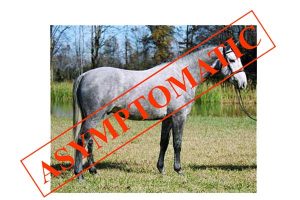Equine Viral Arteritis (EVA)
There are many myths and much misinformation surrounding the disease equine viral arteritis (EVA). Here we present a list of facts in an attempt to assist in clarification and education for the breeding public.
- The disease is “equine viral arteritis” and is abbreviated to “EVA”.
- The virus is the “equine arteritis virus” and is abbreviated to “EAV”.
- EVA is primarily a respiratory disease, but also has sexual implications.
- EVA is rarely fatal, although it can be to young foals or debilitated animals.
- The USA is the only developed horse breeding country to not restrict importation of EAV shedding stallions or semen from those stallions.
- Horses can be infected as a result of coming into contact with acutely infectious animals spreading the disease through aerosol droplet transmission (e.g. when sneezing or coughing).
- Horses in the acute stages of EVA may have obvious symptoms including common respiratory symptoms, conjunctivitis, and distal limb, mammary or sheath edema;
- Acutely infectious animals may also be completely asymptomatic!
- Colts or stallions infected by respiratory transmission may become permanent harbourers of the virus in their secondary sex glands, and shed the virus in their semen.
- The EAV requires testosterone presence in order to be harboured, and cannot therefore be harboured in mares or geldings.
- This means that after the acute stages of the disease have passed (about 28 days), neither mares nor geldings will continue to be infectious.
- The only way a shedder stallion can spread the disease is through infected semen once he has passed through the acute stages of the disease (lasting approximately 3 weeks).
- While “shedder” stallions may spontaneously cease to shed, they will not start and stop shedding intermittently.
- Mares may become infected as a result of being bred with semen from “shedder” stallions.
- Because it is a virus, EAV will not not be controlled by the addition of antibiotics to semen extenders. Nor will it be destroyed by freezing the semen.
- Mares may be infected by breeding with infectious cooled or frozen semen.
- Mares infected through breeding will be likely to become pregnant at the same rate as if bred with non-infective semen and maintain the pregnancy.
- Mares bred with infected semen that become infected themselves will be infectious to others for approximately 3 weeks following the initial infection even though they will be unlikely to lose their pregnancy as a result of EVA.
- If an already pregnant mare is exposed to another animal that is in the acute stages of infections, they may become infected via the respiratory route or expelled semen.
- An already-pregnant mare that becomes infected is likely to abort within the 30 days following infection.
- Unlike some other diseases that cause abortion (e.g. EHV-1, a.k.a. rhinopneumonitis), mares infected by the EAV will always abort within the 30 days following infection. There will not be a “delayed abortion” situation with the abortion occurring later in pregnancy.
- An effective vaccine protecting against EVA is available in North America – “Arvac” (Zoetis Inc., Florham Park, NJ USA).
- Arvac is a modified live virus vaccine, and requires a single injection to stimulate production of adequate antibody levels for protection. Annual booster vaccinations or checking of adequate titer levels is required to ensure protection.
- Because it is a modified live virus vaccine, quarantine of the vaccinated animal is recommended following vaccination.
- Mares should be quarantined for 21 days after vaccination.
- Stallions should be quarantined for 28 days after vaccination.
- It is not necessary to quarantine either following an annual booster vaccination.
- Quarantine requirements are not stringent, and preventing the vaccinated animal from physical or aerosol contact with non-vaccinated animals is adequate.
- Quarantine is required primarily to prevent the slight risk of seroconversion of non-vaccinated animals that may come into contact with the newly vaccinated animal. Such seroconversion could cause traceback complications in the event of an outbreak.
- Quarantine is also required because of the unlikely possibility of an animal becoming acutely infected by the modified live virus of the vaccine and potentially infecting others.
- Although this can theoretically happen it has never been seen to happen, and is therefore a very, very slight risk barely worthy of consideration.
- In countries outside North America, the vaccine “Artervac” (also a product of Zoetis Inc.) may be available. This is an inactivated virus vaccine.
- Artervac requires two initial vaccinations about 3-6 weeks apart, and boosters are required in some countries on a six-monthly interval.
- Quarantine of stallions following vaccination is recommended to prevent the stallion coming into contact with an acutely infectious animal prior to his own antibody levels becoming adequately elevated to prevent him becoming acutely infected himself, and subsequently a shedder of the virus in his semen.
- Vaccinated animals will have EAV antibodies in their blood (be “seropositive“), and there is no way to differentiate between vaccinated animals and animals exposed to acute infection based upon a blood test.
- Stallions that have been vaccinated and kept vaccinated prior to being exposed to an acute infection will not harbour, nor shed the virus in their semen.
- This can be confirmed by a virus isolation test of the semen.
- There are a mere handful of countries in the world that prevent importation of seropositive animals, or semen from seropositive animals.
- These countries are not major horse producing countries.
- Major horse-producing countries such as the EU, Australia, New Zealand and Japan will allow importation of seropositive stallions, or semen from them, as long as the semen has been shown to be absent of the virus (indicating they are not “shedders”).
- Seropositive mares are retested 3 weeks after the initial test that showed positive, and as a second positive test is likely, it is assumed that the mare was either previously vaccinated, or was acutely infected at the time of the initial testing, and is therefore no longer infectious.
- It should be noted that both the Arvac and Artervac vaccines periodically become unavailable, and production regularity or continuity is variable.
A more detailed explanation than this equine viral arteritis factfile can be found in our Equine Viral Arteritis article.
Glossary of Terms
Acutely infected/acute: Any animal (mare, stallion or gelding) in the active stages of infection – not a stallion that is harbouring and shedding.
Chronically affected: An animal with long-term effects. A stallion shedding virus in his semen would be considered to be chronically affected.
Seropositive: An animal that tests positive for the presence of antibodies against a disease in their blood.
Seroconvert/seroconversion: An animal that was previously negative, but then tests positive for antibody presence in the blood.
© 2008 Equine-Reproduction.com, LLC
Use of article permitted only upon receipt of required permission and with necessary accreditation.
Please contact us for further details of article use requirements.
Other conditions may apply.




